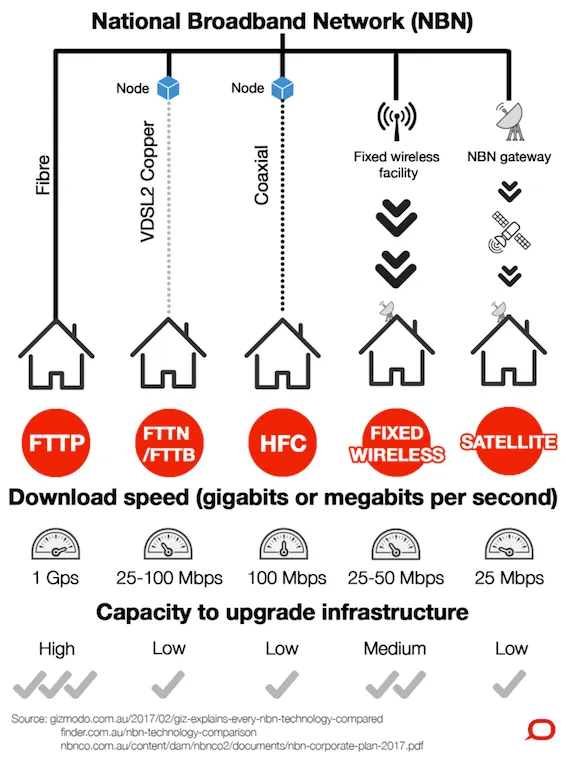
The National Broadband Network (NBN) is failing Australians in droves. Since the initial plan was announced in 2009 by the Australian Government, the project has been plagued by delays and continual dropouts across the network.
In 2013, the new Coalition government suspended the initial plan of a 93% coverage of Fibre-to-the-Premises (FTTP) and announced a patchwork quilt of lower quality infrastructure to connect premises around the country. The following technologies will be used to rollout the NBN:
- Fibre-to-the-Node (FTTN) – running fibre to a node and using existing copper lines that are already connected to premises
- Hybrid Fibre-Coaxial (HFC) – using existing coaxial infrastructure to connect premises
- Fixed Wireless – internet delivered to premises through current wireless technologies
- NBN Gateway - Satellite connections to the most remote premises

Unfortunately more delays have actually resulted in fewer premises being connected at this time compared to the original plan and huge blowout costs for the project.
Social Inequity to NBN Technologies
Now it appears that an analysis of NBN technologies suggest that areas of greatest socio-economic disadvantage are typically receiving NBN infrastructure of poorer quality. To determine socio-economic disadvantage, the research used the Australian Bureau of Statistics’s (ABS) socio-economic indexes for area (SEIFA).
The research found that:
- Only 29% of areas with a SEIFA decile of one had FTTP or FTTN connections
- However, 93% of areas with a SEIFA of decile of 10 (the highest score) had FTTP or FTTN

Source
This research clearly shows the disparity of access to the faster NBN technologies between areas of socio-economic advantage and dis-advantage.
A faster internet connection is increasingly central to people’s social connections, education opportunities, employment prospects and ability to access services. The government has already recognised the importance of the NBN in enhancing greater equity for regional and rural areas to access digital services.
Previous research has also shown that people from lower socio-economic areas are already restricted in their access and use of digital ICT’s. Those with the greatest need will continue to fall further behind if they receive poorer quality digital infrastructure.
The NBN must ensure that socio-economic disadvantage is not further entrenched by provided lesser quality technologies and infrastructure to people who are in need the most.
I hope that this research finds its way to the NBN and decisions are made, not based on money, but based on the basic needs of the neediest people in Australia and appropriate decisions are made to lessen the social inequities that have already been made.
